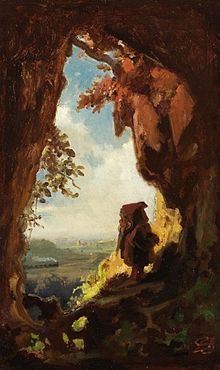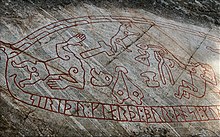Dwarf (mythology)
Dwarves is a collective name for human-shaped, small mythical creatures of folklore, who usually live underground in caves or in the mountains. They have their origins in Norse mythology.
Dwarves are often said to have superhuman strength and power. They are considered cunning and magical, sometimes cunning, stingy and treacherous, but mostly helpful, and especially in later times, in fairy tales and legends, they are depicted as bearded men with pointed hats.
They appear above all as skillful smiths, whereby the term "smith" (Old Norse: smiðr, Icelandic: smiður) originally meant a craftsman who knew how to handle both wood and metals, generally an artisan (cf. also Geschmeide), in a figurative sense an artist, creator (cf. e.g. the "rhyming smith"). In times of little division of labour, the smiths often mined the required ores themselves and also smelted them. Thus the dwarves were also considered to be capable miners and metallurgists. Later, they also practiced all kinds of agricultural and domestic activities and worked in "bourgeois" trades, such as tailors, bakers, and shoemakers.
Unlike goblins, who are single individuals tied to a particular house, place, or family, dwarves live in the company of their peers, much like humans: In archaic times they lived in clans under leaders (e.g. Dvalin's band), in the Middle Ages they had kings (e.g. Laurin), and later they also lived in cities (e.g. the Heinzelmännchen in Cologne).
Dwarves also play a role in the novellas and fiction of German Romanticism. To this day, the collection of folk tales by the Brothers Grimm and the dwarf motifs depicted in them are influential worldwide. No less influential are the resulting receptions from the 20th century, such as the animated film adaptation of the Grimm fairy tale Snow White by Walt Disney. Likewise, dwarves are found in modern fantasy literature, here unmistakably influenced by the conception of dwarves in J. R. R. Tolkien's works, especially in The Lord of the Rings and The Hobbit.
Baroque sculptures of dwarfs were often popular in Central Europe as part of Baroque gardens, for example in the city of Salzburg in the Mirabell Gardens. Today's garden gnomes developed from the combination of such representations of court gnomes with fairy-tale gnomes.

Gnome, looking at a railway, by Carl Spitzweg (about 1848)
Etymology
The Germanic words for "dwarf" (Old High German twerg, Middle High German twerc / querh (masculine, neuter) zwerc, Old Saxon gidwerg (neuter), Old Norse dvergr, Old English dweorg, Old French dwerch, Swedish dvärg, Norwegian dverg, Danish dværg, Dutch dwerg, English dwarf) point to a Ugrian preform *đwerʒaz. However, an etymological connection is uncertain. Perhaps it is related to the verb trügen ("to deceive"), cf. ahd. gidrog ("ghost"), also Old Ind. dhvaras ("demonic being").
Norse mythology
Dwarves are mentioned primarily in the two texts known as the Edda, as well as in several Icelandic sagas that are also Old Norse.
They dwell under the mountains and rocks, and in caves in the earth, according to the skaldic Kenningar of the 11th and 12th centuries and the sagas of the 13th and 14th centuries. The dwarves of Sindri's lineage live in a golden hall in Nidawellir, in the north.
That dwarves were originally imagined as particularly small is not proven; rather, they seem to be shape-shifters who can also appear in the form of animals (perhaps also of deer). Thus Fafnir, the brother of the dwarf Regin, assumes the form of a dragon with the aid of the Helm of Dread. Their common brother Ottur preferred the shape of an otter.
With the help of a magic hat (dwarven hat or huliðshjálmr), sometimes also by a cloak, they can make themselves invisible (see: cloak of invisibility).
Origin
About the origin of the dwarves there are different divergent statements in the Eddic texts. In the Völuspá the creation of the dwarves from the blood of the giant Brimir and the bones of the giant Bláinn is presented in the context of general cosmogony. In stanzas 9 and 10 this reads:
| Þá gengu regin öll á rökstóla, ginnheilög goð, ok um þat gættusk, hverir skyldi dverga dróttir skepja ór Brimis blóði ok ór Bláins leggjum. Þar var Móðsognir mæztr of orðinn dverga allra, en Durinn annarr; þeir mannlíkun Mörg of Gerðu dvergar í jörðu, sem Durinn sagði. | To the judgment seat went the raters all, holy gods, and held council, who of the dwarves flock should manage of Brimir's blood and Blain's bones. Modsognir ward the most powerful there of all the dwarves, the second Durin; that made some humanoid, as Durin put it, the cave dwarves. |
Snorri, on the other hand, reports that the dwarves were maggots in the flesh of the primordial giant Ymir, who were then endowed with intellect by the gods. He equates them with a subgroup of the Albs, namely the Black Albs (svartálfar), thus belonging to the Elves.
Dwarves and gods
Already in the Edda and the Völsunga saga we find the motif of the dwarves as treasure keepers. Here Andvari, a dwarf in the shape of a pike, possesses a hoard of unclear origin and the ring Andvaranaut. After Andvari was captured by Loki, the dwarf was forced to hand over the hoard along with the ring to the Aesir in order to ransom himself. In revenge, he put a curse on the treasure (see: Nibelungen hoard).
Since dwarves also show traits of demons of the dead (they have names like Nár "corpse", Náinn "the dead", Bláinn ("blue" symbolizes the color of death), Dáinn "death"), there is perhaps a connection here to sagas about adventurers who descend into a burial mound to rob the grave goods. There they have to fight very handily with the owner of the treasures, a "living dead" (Draugr).
Characteristic is the wisdom of the dwarves, which can also be evidenced in their names: Regin ("counsel-holder"), Wit ("the wise"), Alvís ("the omniscient"), Fjölsviðr, Rásviðr, etc. In Alvíssmál, Thor makes the dwarf Alvís reveal his great cosmological knowledge; when the sun rises, he is frozen to stone. According to other tales, however, the dwarves seem to be impervious to the sun's rays, and this quality is otherwise ascribed rather to the giant-like trolls.
Some dwarfs even have cosmological significance, such as Nyi and Nidi, which control the phases of the moon, or Norðri, Suðri, Austri and Vestri, which carry the sky formed from Ymir's skull.
The artistry of the dwarves exceeds that of humans, for they also possess magical powers. Thus they made for Odin the spear Gungnir and the gold ring Draupnir. Thor received the hammer Mjölnir. For Freyr they made the ship Skidbladnir and the (automatic?) boar Gullinborsti. For Freya they created the collar Brisingamen and her mount, the boar Hildisvini. Furthermore they wove the fetter Gleipnir for the Fenriswolf and Sif's golden hair. Regin forges the sword Gram with Sigurd. In the Hervörlied (Hervararkvida) the dwarves Durin and Dvalin forge the sword Tyrfing. Although their treasures and trinkets sometimes cause strife and envy among the gods, the dwarves hereby show themselves to be fundamentally helpful, for they never make weapons or miraculous things for the giants, the common enemies of men, Aesir and Alb.
List of dwarves in the Norse Völuspá
The stanzas 10 to 16 of the Völuspá contain a list of dwarf names (see in detail: Dvergatal).
Made from Brimir's blood and Blainn's legs:
- Modsognir, the most powerful of all the dwarves and
- Durin, the second most powerful.
- Durin's Horde:
Nyi and Niði, Norðri and Suðri, Austri and Vestri, Althjof, Dvalin, Nar and Nain, Niping, Dain, Bifur, Bofur, Bombur, Nori, An and Onar, Ai, Mjoðvitnir, Vigg and Gandalf, Vindalf, þrain, Þekk and Þorin, Þror, Vit and Lit, Nyr and Nyrað, Regin and Raðvið, Fili, Kili, Fundin, Nali, Heptifili, Hannar, Sviur, Frar, Hornbori, Fræg and Loni, Billing, Bild, Bruni, Buri, Aurvang, Jari, Eikinskjaldi.
- Dvalin's horde:
Draupnir and Dolgþrasir, Hor, Haugspori, Hlevang, Gloin, Dori, Ori, Duf, Andvari, Skirfir, Virfir, Skafið, Ai, Alf and Yngvi, Eikinskjaldi; Fjalar and Frosti, Fið and Ginnar.
- Other dwarves:
Brokkr, Eitri, Fafnir, Galar, Hreidmar, Ótr, Sindri, Hadhod, Pandar.

Detail of the Ramsund carving (Sweden; 11th century): Sigurd surrounded by the three sons of the sorcerer Hreidmar. The long body of the dragon Fafnir, slain by Sigurd, serves as the frame for the runic inscription. Sigurd is roasting its heart over a fire (thus gaining an understanding of the language of the birds). Ottur (or Ótr, above) was long dead at the time of the dragon fight. He is only depicted here because his death became the catalyst for the ensuing entanglements surrounding the Nibelungen hoard. The dwarf Regin (also slain by Sigurd after a warning from the birds), on the other hand, is depicted as a short-legged, bearded man surrounded by his blacksmith's tools: hammer, bellows, anvil and tongs.
Search within the encyclopedia